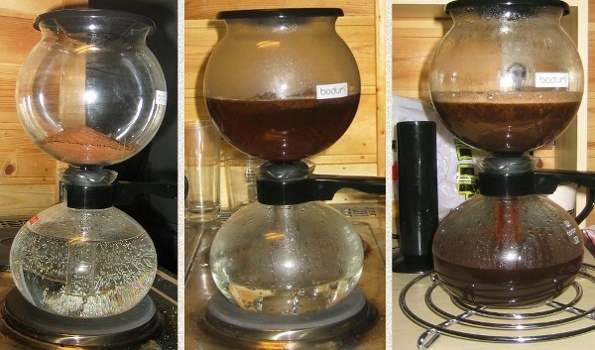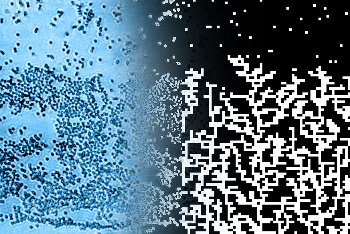Coffee Ring Physics
February 11, 2013
I can imagine the
television commercial.
"Tired of those coffee rings on your dining room table? Eliminate them with Ring Banish, the miracle additive to your morning coffee that prevents those unsightly rings! Works for tea, too!"
What this fictional ad will mention only briefly are the hefty shipping and handling fees; and the fact that the rings are replaced by dark
circles. A method of producing coffee circles instead of rings was found in a 2011
scientific study by
physicists at the
University of Pennsylvania.[1-2] They've now added an extra dollop of
physics by explaining this
phenomenon in collaboration with a colleague at another institution.
I reviewed the science of coffee rings in two previous articles,
Coffee Rings, December 10, 2010 and
Coffee Rings (Part II), August 25, 2011. Coffee is a
colloid; that is, it's a solution of
solid particles suspended in a
liquid. Coffee rings form because of the outward flow of these suspended particles.
Robert D. Deegan and his colleagues at the
James Franck Institute and the
University of Chicago made the first scientific observations of coffee ring formation in 1997.[3-4] They discovered that the mechanism for formation of a coffee ring is as follows:
1. The liquid surface is pinned at its contact line with the substrate.
2. The liquid evaporating at the exterior edge, which is the larger liquid reservoir, is replenished by liquid from the interior.
3. There is a constant flow of liquid from the interior to the exterior.
4. This flow carries nearly all dispersed solids towards the edge.
the coffee ring effect also occurs with
red wine,
milk,
tea and
soup. Such a universal property of colloids makes coffee ring formation a worthwhile target for
experiment. One such experiment showed that the size of the suspended particles is important. Colloidal solutions of 100
nm particles will only form rings if the coffee ring is at least 10
μm.[5]
Since size matters, the next step is to determine whether particle shape matters. The 2011 work by the Penn physicists showed that
ellipsoidal particles will not make coffee rings, since the ellipsoidal particles jam together to form immobile clumps. Spherical particles need to be stretched by just 20% into ellipsoids to eliminate ring formation. Adding just a small faction of ellipsoidal particles to a suspension of spheres will also prevent coffee ruing formation; thus, the basis of the fictional
Ring Banish product mentioned earlier.

There even a lot of physics involved in coffee making. One method of preparing coffee, invented in the 1830s, is the vacuum coffee maker. This coffee making technique, which has been largely supplanted by automatic drip coffee makers, works as follows. The pressure of steam from boiling water drives hot water up a tube into an upper chamber where it's mixed with coffee grounds. When the coffee maker is removed from heat, the subsequent vacuum in the empty lower chamber pulls the brewed coffee back to the lower chamber. A filter at the upper part of the tube prevents the coffee grounds from entering the lower chamber. (Source images, left, center and right, via Wikimedia Commons.)
In the latest coffee ring study, the Penn physicists were joined by
Alexei Borodin of
MIT.[6-9] Borodin had noticed that the processes discovered in the earlier Penn work were similar to
random walk simulations he had done.[9] For coffee rings, the random motion was the shape of the air-colloid
interface.
Interfacial growth processes usually fall into one of two classes; namely, "
Poisson" and "
Kardar-Parisi-Zhang" (KPZ) processes. In Poisson growth, the growth is random in both
space and
time, so the growth of one interfacial region is independent of all others. In Kardar-Parisi-Zhang growth, however, the growth of a region will depend on its neighbors.[9]
In an
analogy to the popular
Tetris game for which the blocks are single
squares, Poisson Tetris will have stacks of larger and shorter blocks in side-by-side columns with the effect that the top surface is very
rough. The blocks in KPZ Tetris, however, are "sticky," so they don't always fall to the bottom of their column. As a result, the KPR Tetris surface is smoother.[9]

(University of Pennsylvania image by Felice Macera.)
Although many
simulations of Kardar-Parisi-Zhang growth have been done, there are few
experiments which have demonstrated this growth. One practical problem is that
impurities in a system will disrupt the mechanism. Another problem is that many experimental observations are required to get enough data for comparison with
theory. You must characterize things as small as the individual particles, and things as large as the interfacial growth front.[9]
Twenty percent
ellipsoidal stretching marked the boundary between Poisson, or coffee ring, growth; and KPZ, or coffee circle, growth. At a considerable stretch of 250%, a third growth process, "Kardar-Parisi-Zhang with Quenched Disorder" (KPZQ) was observed. In analogy to the
Matthew effect,[10] this is also called the "colloidal Matthew effect," since growth of the interface is proportional to the local particle density; that is, the particle-rich regions get richer, and the particle poor regions stay poor.[6-7,9]
Tom Lubensky, Christopher H. Browne Distinguished Professor of Physics at Penn, had this to say of the research.
"The nice thing about this work is that it is in a surprising place... Nobody ever expected that an evaporating colloid would be an interesting place to look for the physics of interfacial growth."[8]
Apart from our fictional "Ring Banish" product, there may be applications for these results.
Paints are colloids, and smooth coatings are
aesthetically pleasing. There may be alternatives to
energy-intensive coating techniques designed for smoothness. This
research was supported by the
National Science Foundation.[9]
References:
- Peter J. Yunker, Tim Still, Matthew A. Lohr and A. G. Yodh, "Suppression of the coffee-ring effect by shape-dependent capillary interactions," Nature, vol. 476, no. 7360 (August 18, 2011), pp. 308-311.
- Jan Vermant, "Fluid mechanics: When shape matters," Nature, vol. 476, no. 7360 (August 18, 2011), pp. 286-287.
- Robert D. Deegan, Olgica Bakajin, Todd F. Dupont, Greb Huber, Sidney R. Nagel and Thomas A. Witten, "Capillary flow as the cause of ring stains from dried liquid drops," Nature, vol. 389, no. 6653 (23 October 23, 1997), pp. 827-829.
- Diana Steele, "Coffee stains - Fundamental physics revealed in a drop of java," University of Chicago Chronicle, vol. 17, no. 3 (Oct. 23, 1997).
- Xiaoying Shen, Chih-Ming Ho and Tak-Sing Wong, "Minimal Size of Coffee Ring Structure," J. Phys. Chem., vol. B114, no. 16 (March 31, 2010), pp 5269-5274.
- Peter J. Yunker, Matthew A. Lohr, Tim Still, Alexei Borodin, D. J. Durian and and A. G. Yodh, "Effects of Particle Shape on Growth Dynamics at Edges of Evaporating Drops of Colloidal Suspensions," Phys. Rev. Lett., vol. 110, no. 3 (January 18, 2013), Document No. 035501, 5 pages.
- Peter J. Yunker, Matthew A. Lohr, Tim Still, Alexei Borodin, D. J. Durian and and A. G. Yodh, "Effects of Particle Shape on Growth Dynamics at Edges of Evaporating Drops of Colloidal Suspensions," arXiv Preprint Server, September 19, 2012.
- Kim Krieger, "Coffee Stains Test Universal Equation," Physics vol. 6, no. 7 (January 18, 2013), DOI: 10.1103/Physics.6.7.
- Penn Physicists Help Show Math Behind Growth of 'Coffee Rings', University of Pennsylvania Press Release, January 18, 2013.
- "For unto every one that hath shall be given, and he shall have abundance: but from him that hath not shall be taken even that which he hath," Matthew 25:29 (King James Version).
- The Coffee Ring Effect - Intriguing Microscopic Video, University of Pennsylvania Department of Physics and Astronomy, YouTube video, Aug 11, 2011.
Permanent Link to this article
Linked Keywords: Television advertisement; television commercial; coffee ring; coffee; tea; circle; science; scientific study; physicist; University of Pennsylvania; physics; phenomenon; colloid; solid; liquid; Robert D. Deegan; James Franck Institute; University of Chicago; evaporation; evaporating; red wine; milk; tea; soup; experiment; nanometer; nm; micrometer; μm; ellipsoid; ellipsoidal; coffeemaker; coffee making; vacuum coffee maker; automatic drip coffee maker; vapor pressure; pressure of steam; boiling; water; coffee grounds; vacuum; brewed coffee; filter; Wikimedia Commons; Alexei Borodin; Massachusetts Institute of Technology; MIT; random walk; interface; Poisson process; Kardar-Parisi-Zhang; space; time; analogy; Tetris; square; surface roughness; rough; Felice Macera; computer simulation; simulation; impurity; impurities; theory; Matthew effect; Tom Lubensky; paint; aesthetics; efficient energy use; energy-intensive; coating; research; National Science Foundation.